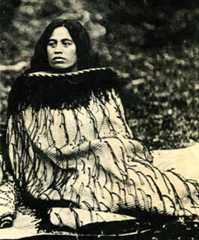Story: Te mana o te wāhine – Māori women

To Māori, women are tewharetangata – the house of humanity – and are venerated for their ability to create life. Many strong women have been prominent in Māori society, including the Māori queen, Dame Te Atairangikaahu, and land-rights activists Eva Rickard and Whina Cooper.
Story by Rawinia Higgins rāua ko Paul Meredith
Main image: Mihi Kōtukutuku
Story summary
Māori call women ‘tewharetangata’ (the house of humanity), and respect them for their ability to create life.
Goddesses
Wāhineatua (goddesses) in Māori tradition include:
- Papatūānuku, the earth mother and creator of all life
- Hineahuone, the first woman
- Hinetītama, who fled to the underworld and became Hine-nui-te-pō, the goddess of death, when she realised that her husband, Tāne, was also her father
- the women who feature in the deeds of the demigod Māui.
Tapu and noa
Traditionally, menstruating women were seen astapu (sacred or restricted). They stayed away from food storage areas and gardens, and did not associate with men.
Women had the ability to whakanoa (removetapu). They took part in whakanoa ceremonies for new buildings, and for warriors returning from battle.
Women of rank
First-born girls in chiefly families were seen astapu. Their status aspuhi (virgins) was guarded by theirhapū, so they could marry a suitable man from another community. Some women ofmana receivedmoko kauae (female chin tattoos).
Well-known women of rank include:
- Hinematioro, leader of Te Aitanga a Hauiti, who was said to be sotapu that she did not walk on the ground, but was carried on a litter
- Rangi Topeora, a Ngāti Toa leader who signed the Treaty of Waitangi
- Dame Te Atairangikaahu, the first Māori queen.
Waiata (songs) and marae protocol
Many Māori women have been poets and composers, including 19th-century composer Puhiwahine, and Tuini Ngāwai and Ngoingoi Pēwhairangi in the 20th century.
The karanga – the first cry of welcome on amarae – is done by women. In some tribes, both women and men can make speeches on themarae, but in others, only men can speak.
Colonisation
Māori women traditionally had a say in the affairs of the tribe, and could inherit land. However, European settlers often preferred to deal with men. Only 13 women signed the Treaty of Waitangi. Māori women continued to fight for land rights, and for the vote for women.
Activism and politics
The Māori Women’s Welfare League was set up in 1951 to support Māori, especially as they moved into the cities. Many women fought for land rights, and to revitalise the Māori language. Activists included Eva Rickard and Whina Cooper.
The first Māori woman MP was Iriaka Rātana, elected in 1949.
How to cite this page
Rawinia Higgins rāua ko Paul Meredith, Te mana o te wāhine – Māori women, Te Ara – the Encyclopedia of New Zealand, https://teara.govt.nz/en/te-mana-o-te-wahine-maori-women (accessed 27 October 2025).
Story by Rawinia Higgins rāua ko Paul Meredith, published 11 June 2013, updated 1 June 2017.



